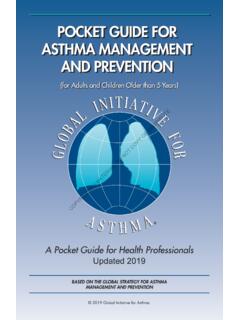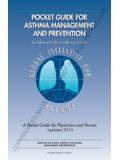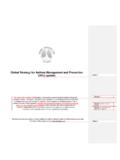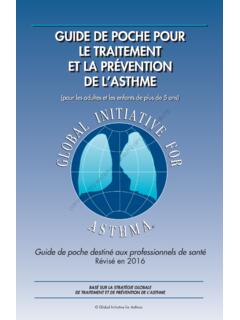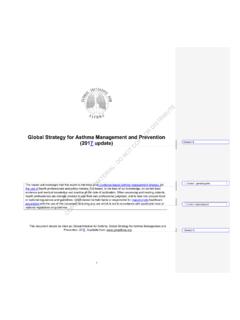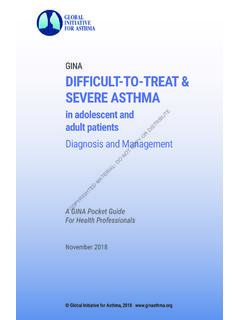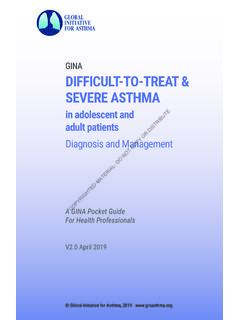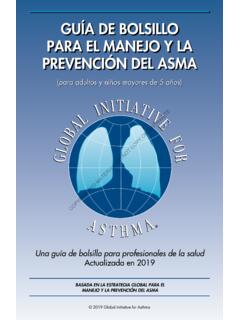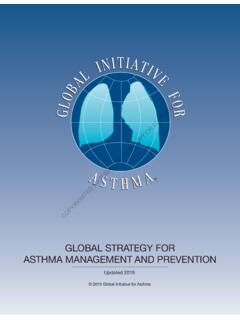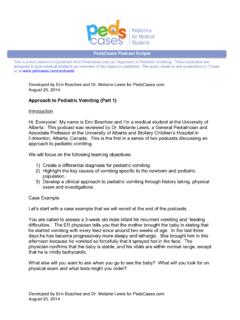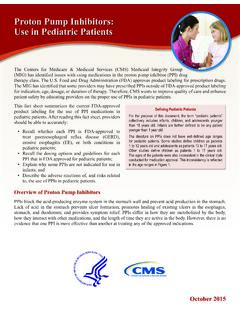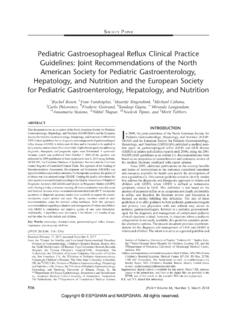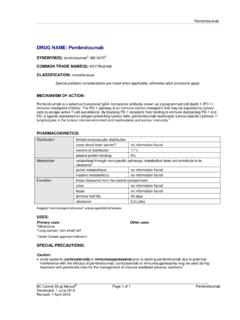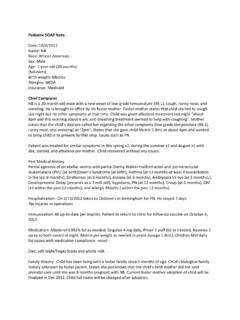Transcription of POCKET GUIDE FOR ASTHMA MANAGEMENT AND …
1 POCKET GUIDE FORASTHMA MANAGEMENT AND PREVENTIONA POCKET GUIDE for Health Professionals Updated 2020(for Adults and Child ren Older than 5 Years)BASED ON THE GLOBAL STRATEGY FOR ASTHMAMANAGEMENT AND PREVENTION 2020 Global Initiative for ASTHMA COPYRIGHTED MATERIAL- DO NOT COPY OR DISTRIBUTE 1 GLOBAL INITIATIVE FOR ASTHMA ASTHMA MANAGEMENT AND PREVENTION for adults and children older than 5 years A POCKET GUIDE FOR HEALTH PROFESSIONALS Updated 2020 GINA Science Committee Chair: Helen Reddel, MBBS PhD GINA Board of Directors Chair: Louis-Philippe Boulet, MD GINA Dissemination and Implementation Committee Chair: Mark Levy, MD (to Sept 2019); Alvaro Cruz, MD (from Sept 2019) GINA Assembly The GINA Assembly includes members from many countries, listed on the GINA website GINA Executive Director Rebecca Decker, BS, MSJ Names of members of the GINA Committees are listed on page 48.
2 COPYRIGHTED MATERIAL- DO NOT COPY OR DISTRIBUTE 2 LIST OF ABBREVIATIONS BDP Beclometasone dipropionate COPD Chronic obstructive pulmonary disease CXR Chest X-ray DPI Dry powder inhaler FeNO Fraction of exhaled nitric oxide FEV1 Forced expiratory volume in 1 second FVC Forced vital capacity GERD gastroesophageal reflux disease HDM House dust mite ICS Inhaled corticosteroids ICS-LABA Combination ICS and LABA Ig Immunoglobulin IL Interleukin IV Intravenous LABA Long-acting beta2-agonist LAMA Long-acting muscarinic antagonist LTRA Leukotriene receptor antagonist Not applicable NSAID Nonsteroidal anti-inflammatory drug O2 Oxygen OCS Oral corticosteroids PEF Peak expiratory flow pMDI Pressurized metered dose inhaler SABA Short-acting beta2-agonist SC Subcutaneous SLIT Sublingual immunotherapy COPYRIGHTED MATERIAL- DO NOT COPY OR DISTRIBUTE 3 TABLE OF CONTENTS List of abbreviations.
3 2 Interim guidance on ASTHMA MANAGEMENT during the COVID-19 pandemic .. 5 Update on GINA recommendations for mild ASTHMA .. 7 About GINA .. 9 What is known about ASTHMA ? .. 10 Making the diagnosis of ASTHMA .. 11 Criteria for making the diagnosis of ASTHMA .. 12 How to confirm the diagnosis in patients taking controller treatment .. 13 Diagnosing ASTHMA in other contexts .. 13 Assessing a patient with ASTHMA .. 14 How to assess ASTHMA control .. 16 How to investigate uncontrolled 17 MANAGEMENT of ASTHMA .. 18 General principles .. 18 The ASTHMA MANAGEMENT cycle to minimize risk and control 18 GINA recommendations for mild ASTHMA .. 20 Starting ASTHMA treatment.
4 21 Stepwise approach for adjusting treatment for individual patient 31 Reviewing response and adjusting treatment .. 35 Inhaler skills and adherence .. 37 Treating modifiable risk factors .. 38 Non-pharmacological strategies and interventions .. 38 Treatment in specific populations or contexts .. 39 ASTHMA flare-ups (exacerbations) .. 40 Written ASTHMA action plans .. 41 Managing exacerbations in primary or acute care .. 42 Reviewing response .. 44 Follow-up after an exacerbation .. 44 Gl ossary of ASTHMA medication classes .. 45 Acknowledgements .. 48 GINA publications .. 48 COPYRIGHTED MATERIAL- DO NOT COPY OR DISTRIBUTE 4 TABLE OF FIGURES Box 1.
5 Diagnostic flow-chart for ASTHMA in clinical 11 Box 2. Features used in making the diagnosis of ASTHMA .. 12 Box 3. How to assess a patient with 14 Box 4. Assessment of symptom control and future risk .. 15 Box 5. How to investigate uncontrolled ASTHMA in primary 17 Box 6. The ASTHMA MANAGEMENT cycle of shared decision-making .. 19 Box 7A. The GINA ASTHMA treatment strategy adults and adolescents .. 22 Box 7B. Initial treatment: adult or adolescents with a diagnosis of ASTHMA .. 24 Box 8A. The GINA ASTHMA treatment strategy children 6 11 years .. 26 Box 8B. Initial treatment: children 6 11 years with a diagnosis of ASTHMA .. 28 Box 9.
6 Low, medium and high daily doses of inhaled corticosteroids .. 30 Box 10. Self- MANAGEMENT with a written action plan .. 41 Box 11. MANAGEMENT of ASTHMA exacerbations in primary care .. 43 COPYRIGHTED MATERIAL- DO NOT COPY OR DISTRIBUTE 5 INTERIM GUIDANCE ON ASTHMA MANAGEMENT DURING THE COVID-19 PANDEMIC Advise patients with ASTHMA to continue taking their prescribed ASTHMA medications, particularly inhaled corticosteroid (ICS) medications, and oral corticosteroids (OCS) if prescribed ASTHMA medications should be continued as usual during the COVID-19 pandemic. This includes ICS-containing medications (alone or in combination), and add-on therapy including biologic therapy for severe ASTHMA .
7 Stopping ICS often leads to potentially dangerous worsening of ASTHMA . For a small proportion of patients with severe ASTHMA , long-term OCS may sometimes be needed, and it is very dangerous to stop these suddenly. Advise patients to discuss with you before stopping any ASTHMA medication. Make sure that all patients have a written ASTHMA action plan An action plan tells the patient how to recognize worsening ASTHMA , how to increase their reliever and controller medications, and when to seek medical help. A short course of OCS may be needed during severe ASTHMA flare-ups (exacerbations). See the GINA 2020 report Box 4-2 for more information about the options for ASTHMA action plans.
8 Where possible, avoid using nebulizers due to the risk of transmitting infection to healthcare workers and other patients Nebulizers can transmit respiratory viral particles for approximately 1 meter. Instead, to deliver short-acting beta2-agonist for acute ASTHMA in adults and children, use a pressurized metered-dose inhaler and spacer, with a mouthpiece or tightly fitting face mask, if required. Avoid spirometry in patients with confirmed/suspected COVID-19 Spirometry can disseminate viral particles and expose staff and patients to risk of infection. While community transmission of the virus is occurring in your region, postpone spirometry and peak flow measurement within health care facilities unless there is an urgent need.
9 If spirometry is needed urgently for clinical MANAGEMENT , follow infection control recommendations. COPYRIGHTED MATERIAL- DO NOT COPY OR DISTRIBUTE 6 Follow infection control recommendations if other aerosol-generating procedures are needed These include oxygen therapy (including with nasal prongs), sputum induction, manual ventilation, non-invasive ventilation and intubation. World Health Organization (WHO) recommendations are found here: (ncov)-infection-is-suspected-20200125 Follow local health advice about hygiene strategies and use of personal protective equipment, as new information becomes available in your country or region. Additional resources The website of the US Centers for Disease Control and Prevention (CDC) provides up-to-date information about COVID-19 for health professionals: , and patients: The website of the World Health Organization (WHO) provides comprehensive advice for health professionals and health systems about prevention and MANAGEMENT of COVID-19: Global Initiative for ASTHMA , April 3, 2020 COPYRIGHTED MATERIAL- DO NOT COPY OR DISTRIBUTE 7 UPDATE ON GINA RECOMMENDATIONS FOR MILD ASTHMA The 2019 GINA strategy report represented the most important change in ASTHMA MANAGEMENT in 30 years.
10 For safety, GINA no longer recommends treatment with short-acting beta2-agonists (SABA) alone, without inhaled corticosteroids (ICS). There is strong evidence that SABA-only treatment, although providing short-term relief of ASTHMA symptoms, does not protect patients from severe exacerbations, and that regular or frequent use of SABAs increases the risk of exacerbations. GINA now recommends that all adults and adolescents with ASTHMA should receive ICS-containing controller treatment. This can be either symptom-driven (in mild ASTHMA , GINA Steps 1 to 2) or daily (GINA Steps 2 to 5), to reduce the risk of serious exacerbations and to control symptoms.
